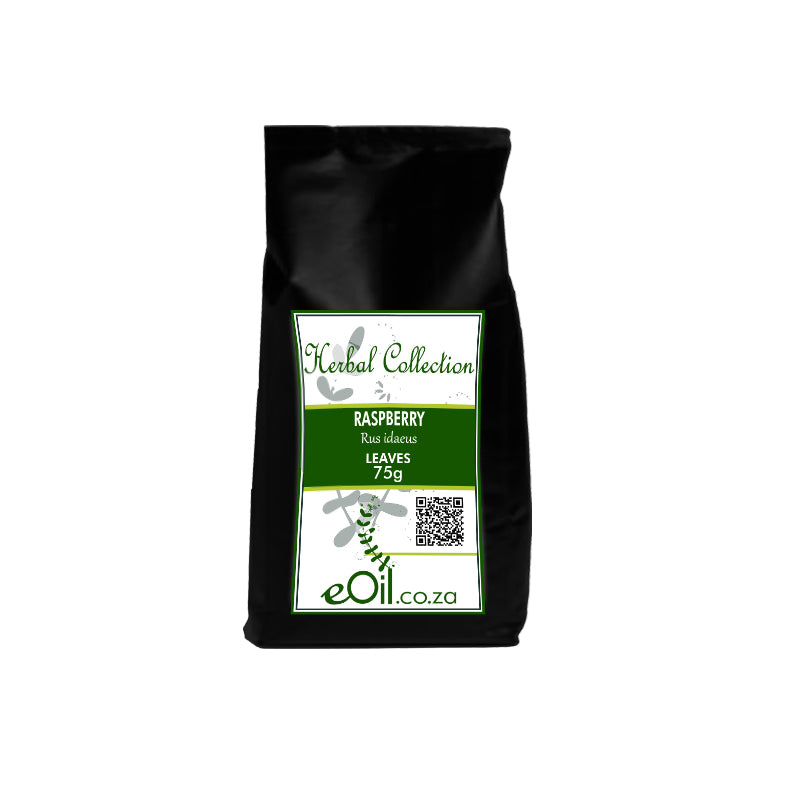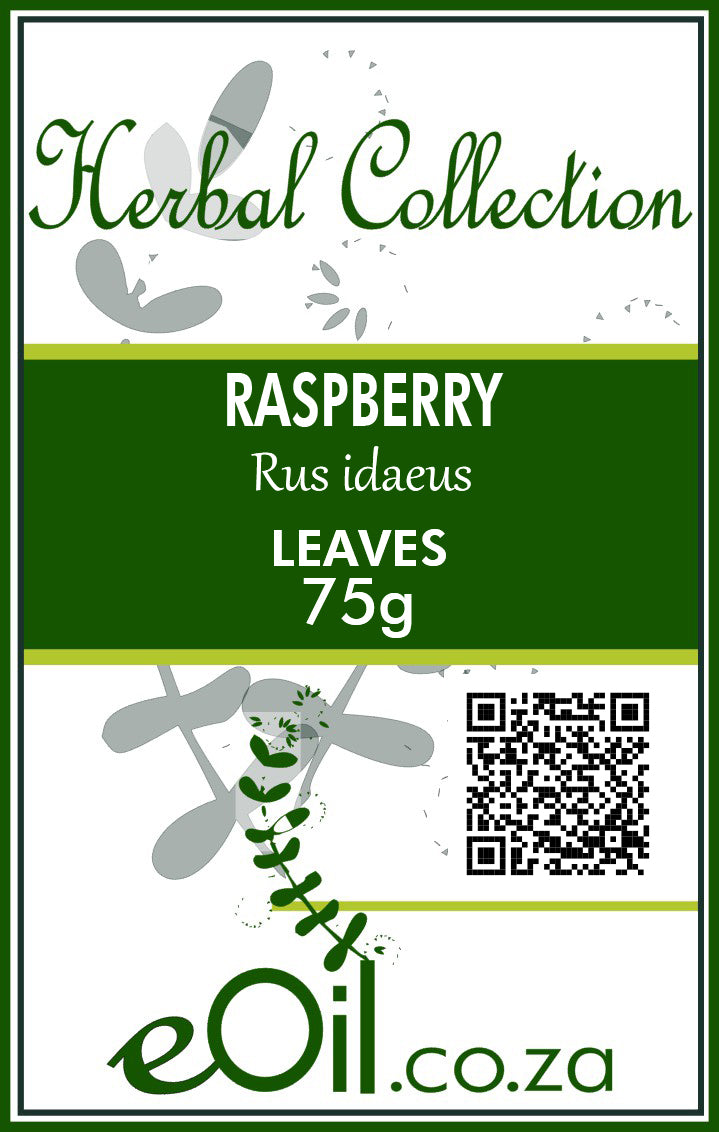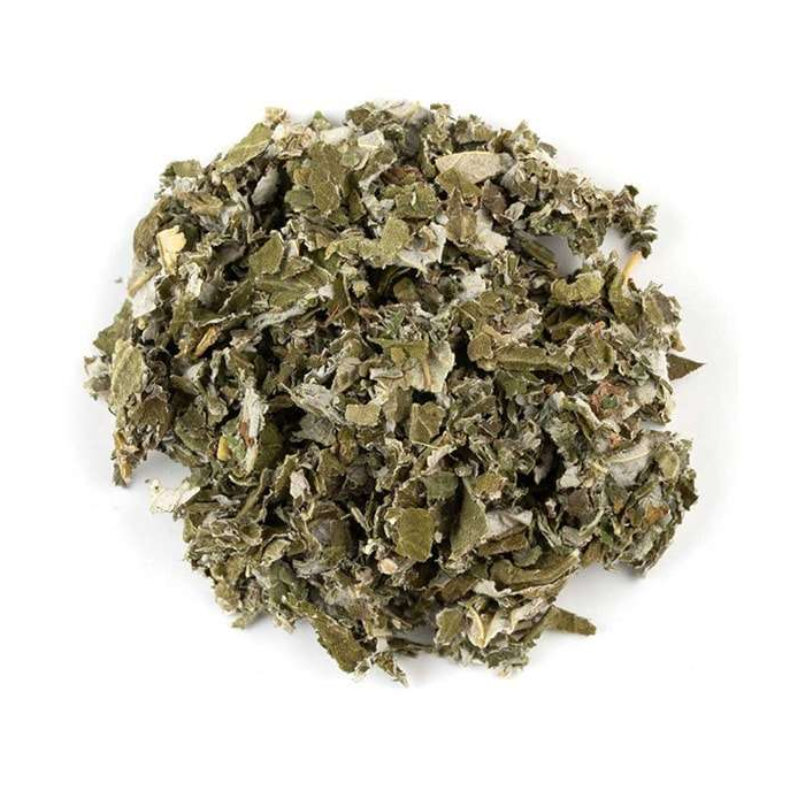Raspberry Leaves Dried - Herbal Collection
Raspberry Leaves Dried - Herbal Collection - 75 GR is backordered and will ship as soon as it is back in stock.
Description
Description
Raspberry Leaves Dried - Herbal Collection - 75 g
Dried raspberry leaves, harvested from the Rubus idaeus plant, are a traditional herb with a long history of use.
They are often steeped into a nourishing tea, known for its mineral content and traditional use in supporting women's wellness.
Raspberry leaf tea is also enjoyed for its pleasant flavor and potential to promote relaxation.
For in depth information, please check tabs below
TRADITIONALLY USED FOR
Raspberry leaf tisane (Rubus idaeus) is an herbal tea with a long history of use, particularly within women's health traditions.
Raspberry leaf's slightly astringent flavor profile makes it a pleasant tea to drink throughout the day.
To prepare raspberry leaf tisane, steep 1-2 teaspoons of dried raspberry leaves in hot water for 5-10 minutes.
Enjoy it warm or chilled, and sweeten with a touch of honey if desired.
While generally regarded as safe, always consult your doctor before using raspberry leaf tisane, especially if pregnant or breastfeeding.
INFORMATION
Source : http://www.wikiphyto.org/wiki/raspberry
Reference on http://www.wikiphyto.org
Translation in English by Google Translate (go to the page of the source linked | on Chrome cellphones go on the 3 dots on the top right and select translate in your preferred language | on laptop right click your mouse and select option translate when hoovering on the page
plant name
Raspberry, Ida's bramble , Raspberry (English)
International Latin denomination
Rubus idaeus L.
botanical family
Rosaceae
Description and habitat
- A woody , bramble -like perennial shrub with erect, cylindrical stems, found throughout the northern hemisphere
- Stems biennial, root suckering, perennial, emitting new shoots each year. The stems are armed with slightly pungent prickles. The underside of the leaf is whitish and the red fruit is made up of a set of small drupes
- The raspberry is often associated in its natural environment with beech , mountain ash or elderberry
- According to Pol Henry [1] , it is an indicator plant of a certain degradation of the soil, by acid blocking of the fertilizing properties of the humus. It lives in the sessiliflorous silicolous oak forest and the acidophilic beech forest. It is the forest which is degrading, acidifying, adapted to leached soils, to clayey sands where the cuts lead to the growth of brambles
History and tradition
- Its name ( Rubus idaeus “ Ida bramble ”) comes from the fact that the raspberry was born on the slopes of Mount Ida, home of the gods of Olympus, the name of the genus Rubus coming from the Latin ruber which means “red” , with reference to the fruits of the many species of this family or to the coloring that the leaves of some of them bear in autumn, and because of its presence in the undergrowth, European botanists classified it as 19th century among the tribe of the “Dryads”, named after the nymphs whose life was linked to that of the trees and the forest [2]
- Its culture in Europe dates back to the end of the Middle Ages
- Red raspberry leaf has traditionally been used to promote labor in parturients and to reduce pain during childbirth
Parts used
- Sheets
- Young plants
Dosage forms available
- Leaf tincture
- Young growth glycerine macerate
- Juice
Usual dosages
Composition
Main components of the plant
- Sheets :
- Tannins
- Flavonoids : kaempferol , quercetol and derivatives [3]
- Lignanes ( fragrine , a lignane
- Organic acids
- Fruit :
- Vitamin C (fruit)
- Raspberry ketone ( 4-(4-hydroxyphenyl) butan-2-one ) in the fruit
Main components of buds or young shoots
- Polyphenols :
- Ellagic Acid , Sanguine H-6, Catechins (13.25%), Flavonols (8.71%), Cinnamic Acid , Benzoic Acid
Main components of essential oil
Properties
Plant properties
- Leaf :
- Tonic
- Astringent
- Diuretic
- Uterotonic, aqueous extract of raspberry leaves produced increased contraction of mouse uterine muscles [4] , effect antagonized by salbutamol and nifedipine
- The effect could be reversed depending on the concentration and become utero-relaxing
- Antioxidant (fruits and leaves) [5] , [6]
- Fruit :
- Fruit lignans have phytoestrogenic properties [7]
- The raspberry ketone ( 4-(4-hydroxyphenyl) butan-2-one ) from the fruit is an aromatic phenolic compound similar in structure to capsaicin and synephrine , known to exert an anti-obesity effect and modulate lipid metabolism [8 ] , [9]
- Sanguine H6 from Rubus coreanus ( Korean bramble or "black raspberry") is a potential anti-angiogenic agent [10]
Bud properties
- Antibacterial ( Corynebacterium diphtheriae ), antioxidant, cytotoxic on cancer cells [11]
- Anti-inflammatory and antioxidant [12]
Properties of essential oil
Indications
Indications of the whole plant (phytotherapy)
- The leaves are useful in preparing for childbirth in the last month of pregnancy.
- Small fruits are useful in the dietetics of cancers [13]
Indications of the bud (gemmotherapy)
- Female hypogonadism (amenorrhea, hairiness) of puberty
- Menopausal menorrhagia due to endometrial hyperplasia
- Secondary amenorrhea of iatrogenic early menopause
- Eutrophic of sexual function and brain activity
- Dysmenorrhea
- Complementary remedies
- tree stratum
- Shrub layer
- Cytological action and on flocculation
- None
Specific indications of essential oil (aromatherapy)
Known or suspected mode of action
Usual formulations
- Glycerine macerate : 50 drops morning and evening
Regulations
Possible side effects and precautions for use
- Avoid raspberry leaf during the first trimester of pregnancy [14]
Bibliographic references
- Go↑ Henry Pol. Gemmotherapy, therapy with plant embryonic extracts. Author's edition. Brussels, 1982.
- Go↑ Chloe Darge. The raspberry, Rubus idaeus L. Thesis presented for the herbalist diploma - IFAPME - Herboristerie - 2018
- Go↑ Gudej, J. (2003). Kaempferol and quercetin glycosides from Rubus idaeus L. leaves. Acta Poloniae Pharmaceutica, 60(4), 313–315.
- Go↑ Olson, A., & DeGolier, T. (2016). Contractile activity of Rubus idaeus extract on isolated mouse uterine strips. Bios, 87(2), 39-47. Retrieved September 9, 2020, from http://www.jstor.org/stable/24878630a
- Go↑ Shiow Y. Wang, Hsin-Shan Lin. Antioxidant Activity in Fruits and Leaves of Blackberry, Raspberry, and Strawberry Varies with Cultivar and Developmental Stage. Journal of Agricultural and Food Chemistry 2000 48 (2), 140-146. [1]
- Go↑ Marja P. Kähkönen, Anu I. Hopia, Heikki J. Vuorela, Jussi-Pekka Rauha, Kalevi Pihlaja, Tytti S. Kujala, Marina Heinonen. Antioxidant Activity of Plant Extracts Containing Phenolic Compounds. Journal of Agricultural and Food Chemistry 1999 47 (10), pp. 3954–3962
- Go↑ Mazur WM, Uehara M, Wähälä K, Adlercreutz H. Phyto-oestrogen content of berries, and plasma concentrations and urinary excretion of enterolactone after a single strawberry-meal in human subjects.Br J Nutr. 2000 Apr;83(4):381-7. PMID 10858696
- Go↑ Morimoto C, Satoh Y, Hara M, Inoue S, Tsujita T, Okuda H. Anti-obese action of raspberry ketone. Life Sci. 2005 May 27;77(2):194-204. PMID 15862604
- Go↑ Park KS. Raspberry ketone increases both lipolysis and fatty acid oxidation in 3T3-L1 adipocytes. Planta Med. 2010 Oct;76(15):1654-8. doi: 10.1055/s-0030-1249860. PMID 20425690
- Go↑ Lee SJ, Lee HK. Sanguiin H-6 blocks endothelial cell growth through inhibition of VEGF binding to VEGF receptor. Arch Pharm Res. 2005 Nov;28(11):1270-4. PMID 16350854
- Go↑ Miros¿awa Krauze-Baranowska, Daniel G¿ód, Marta Kula, Magdalena Majdan, Rafa¿ Ha¿asa, Adam Matkowski, Weronika Koz¿owska, Anna Kawiak. Chemical composition and biological activity of Rubus idaeus shoots - a traditional herbal remedy of Eastern Europe. BMC Complementary and Alternative Medicine 2014, 14:480 (12 December 2014 Abstract texte intégral
- Go↑ Donno D, Beccaro GL, Carlen C, Ançay A, Cerutti AK, Mellano MG, Bounous G. Analytical fingerprint and chemometrics as phytochemical composition control tools in food supplement analysis: characterization of raspberry bud preparations of different cultivars. J Sci Food Agric. 2016 Jul;96(9):3157-68. doi: 10.1002/jsfa.7494. PMID 26459916
- Go↑ Navindra P. Seeram, Lynn S. Adams, Yanjun Zhang, Rupo Lee, Daniel Sand, Henry S. Scheuller, David Heber. Blackberry, Black Raspberry, Blueberry, Cranberry, Red Raspberry, and Strawberry Extracts Inhibit Growth and Stimulate Apoptosis of Human Cancer Cells In Vitro. Journal of Agricultural and Food Chemistry 2006 54 (25), 9329-9339. PMID 17147415
- Go↑ D. Jill Mallory MD, Postdates Pregnancy, in Integrative Medicine (Fourth Edition), 2018 Red Raspberry Leaf
CAUTION
Store in a cool, dry place, away from light. Keep tightly closed, away from the reach of Children and pets.
Do not exceed the daily dose.
This product is not intended to prevent or cure any form of illness or disease.
If you are pregnant or nursing ; If you have a medical condition or are in the course of medical treatment ; If you are programmed for theater/operation in the near future, please consult your healthcare practitioner before using this product.
This product cannot replace a varied and balanced diet and a healthy lifestyle.
This product has not been evaluated by the SAHPRA for its quality, safety or intended use.
For More Information please check our General Safety Herbal products Page






